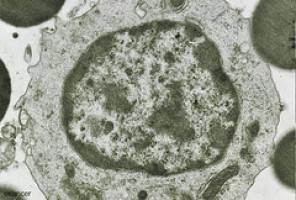
Life is an exquisite orchestration of growth and change, with checks and balances that fine-tune complex entwined interactions, both intrinsic and external.
White blood cells (WBC) are integral to an organism's immune defenses against disease and invasion; unfortunately, these mechanisms may go awry causing uncontrolled increases in dysfunctional cell numbers, resulting in tumour formation.
Now, researchers at the University of Tsukuba have illustrated how mutations in a specific gene called VAV1 may promote tumours involving a type of white blood cell, the T-cell, in experimental mice.
Leukocytes, or WBC, are fundamental to the body's immune function.
They include B-lymphocytes that generate antibodies, as well as thymic-lymphocytes or T-cells with diverse immune-related functions, so called because they develop in the thymus gland.
T-cell neoplasms include a mature subtype called peripheral T-cell lymphoma.
Studies have shown that VAV1, a gene that participates in T-cell receptor signaling, is altered in several peripheral T-cell lymphoma variants; therefore, the research team sought to elucidate the role of VAV1 mutants in the malignant transformation of T-cells in vivo.
The tumour suppressor gene p53 is called 'guardian of the genome' because it prevents genome mutation.
The researchers replicated VAV1 mutations found in human T-cell tumours in both normal ("wild-type") mice and mice lacking p53.
Lead author Kota Fukumoto describes their findings: "No tumours developed in the wild-type mice with VAV1 mutations over a year of observation; whereas immature tumours developed in mice that lacked p53.
Remarkably, mice that both lacked p53 and had mutations in VAV1 developed mature tumours resembling human peripheral T-cell lymphoma, and had poorer prognosis than the mice lacking p53 only."
The team also transplanted tumour cells into mice that lacked a functional thymus.
The results suggested that tumour initiation was likely due to mechanisms within the cell itself.
"We noted that T-cell tumours with VAV1 mutation showed Myc pathway enrichment, as well as somatic copy number alterations (SCNAs), including at the Myc locus," explains Professor Shigeru Chiba, senior author.
Significantly, Myc, a family of regulator genes and proto-oncogenes, and SCNAs, which cause discrepancies in DNA copies, are both distinct hallmarks of tumour formation.
"Interestingly, pharmaceutical inhibition of the Myc pathway increased overall survival of mice harboring VAV1-mutant tumours," Professor Chiba adds.
"Therefore, our methodology and results suggest that the VAV1-mutant expressing mice developed in this study could be a research tool for evaluating therapeutic agents directed against specific T-cell neoplasms."
Source: UNIVERSITY OF TSUKUBA
We are an independent charity and are not backed by a large company or society. We raise every penny ourselves to improve the standards of cancer care through education. You can help us continue our work to address inequalities in cancer care by making a donation.
Any donation, however small, contributes directly towards the costs of creating and sharing free oncology education.
Together we can get better outcomes for patients by tackling global inequalities in access to the results of cancer research.
Thank you for your support.